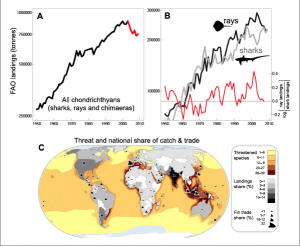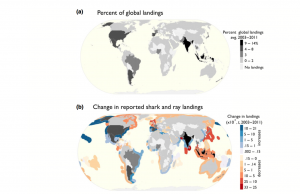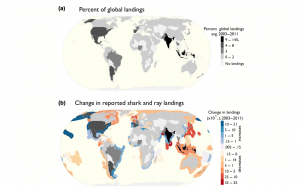By Kyra Hartog, RJD Intern
The natural world is changing rapidly in the face of land and coastal development, climate change, fisheries, and other human impacts. With these changes come conservation concerns for the various species that inhabit these areas impacted by human activities. The International Union for Conservation of Nature and Natural Resources (IUCN) Red List is a valuable conservation tool that allows scientists to determine the conservation status of various plant and animal species around the world. In their recent paper, Dulvy et. al provide a comprehensive assessment of all species of sharks and rays (chondrichthyans) under the IUCN Red List criteria, which provides insight into the rapidly changing biodiversity of the world’s oceans.
The IUCN Red List classifies species in categories ranging from “Least Concern” to “Extinct” based on certain criteria such as reduction in population size, change in geographic range, and number of reproductive individuals in a population, among other measures. Dulvy and his colleagues applied these criteria to 1,041 species of sharks and rays and evaluated each species’ status based on these criteria. They found that over a quarter of the species of sharks and rays could be classified as threated under IUCN criteria, mostly due to overfishing and habitat degradation. The found that large-bodied, shallow-water species had the highest extinction risk of the sharks and rays and that the overall risk for chondrichthyans was higher than that of other vertebrates. Though shark and ray populations have changed significantly due to overfishing and habitat destruction, it is unclear whether these changes are reversible or if they signal a larger problem regarding overall marine species extinction risk.

Figure from Dulvy et. al representing A) the increased reported catch of shark and ray species over time, B) the increased contribution of rays to the global reported chondrichthyan catch, and C) Shark and ray fishing nations based on % of contribution to global reported catch, number of threatened species in each area, and % of contribution to the global fin trade based in Hong Kong
Sharks and their relatives exhibit some of latest maturing and slowest reproducing species of any taxonomic group. Populations of chondricthyan fishes also exhibit extreme life history characteristics such as low population growth rates, weak density-dependent juvenile survival, and increased sensitivity to fishing mortality. Though sharks and rays are often caught as bycatch of fisheries targeting some other species, they are often kept due to the increasing value of their fins and demand for meat, liver oil, and gill rakers (from Manta and other devil rays). These fishing pressures, combined with effects of habitat degradation, make for a potentially disastrous future for chondrichthyan species. Commercial and residential coastal development, mangrove destruction, river engineering, and pollution are the main processes causing freshwater, estuarine, and marine habitat degradation. These human activities alone threaten one third of already threatened shark and ray species.
The most acute effects of these activities are seen in those species that require freshwater and those that can live comfortably in both fresh and salt water: one third of the 90 species in this category are affected severely by habitat degradation. Their risk is exacerbated by the specific nature of their habitats and their small geographic ranges. Mangrove destruction, in particular, has increasingly become an issue in Southeast Asia where mangrove forests are being clear-cut for shrimp farming operations. Human perception of sharks as dangerous has led to increased use of shark control nets at beaches and direct persecution due to shark attacks and supposed damage to aquaculture and other fishery operations. Only one species, the New Caledonia catshark, has been directly threatened by climate change but many others have been recognized as climate sensitive. Climate change hotspots like the Mediterranean Sea should also be monitored for changes in species extinction risk.
Shark and ray species are most threatened when they are large-bodied, coastal-dwelling, exposed to fisheries, and within a narrow depth range. This combination of factors is exemplified in the Sawfish family (Pristidae) and has led to their status as the most threatened chondrichthyan family, and possibly the most threatened family of all marine fishes. Other highly threatened groups include shelf-dwelling rays, angel sharks, and thresher sharks. The least threatened groups are those that are small bodied and somewhat out of reach of fishery operations such as catsharks, chimaeras, and soft-nose skates. Conservation of specific areas is prioritized based on the number of threatened species in that area, the level of expected threat for those species, and the number of threatened endemic species (found only in that area and therefore irreplaceable). Hotspots that fall under these criteria include the Indo-Pacific Biodiversity Triangle and the Red Sea. These areas, among some 15 other conservation hotspots, represent a combination of high threat, low safety, and high uncertainty in extinction risk among the chondrichthyan species that live there.

Level of “irreplaceability” among chondrichthyans in global conservation hotspots. Score is based on the number of small-range (endemic) species found within each area.
While there have not been any known global extinctions, 28 populations of sawfishes, skates, and angel sharks have been driven to regional or local extinction. Sharks and rays have the highest number of species classified as “Data Deficient” by the IUCN among all evaluated taxa. Fourteen percent of these species are likely to be threatened based on their life histories and distribution. Dulvy et. al made a novel observation that minimum depth limit and narrowness of depth range may be more important in determining extinction risk than geographic range, possibly due to the wide-reaching nature of fisheries today. No species can be out of reach of the current global fishing fleets but some may be able to escape capture by inhabiting deeper oceanic zones. These global fisheries represent an issue for international management agencies as it is difficult to monitor so many operations. Listing under conventions such as CITES (Convention of International Trade of Endangered Species) and effective implementation of these listings is key to reducing extinction risk of sharks and rays, globally. Repeated Red List status assessments, proper catch reporting, and sufficient management plans must also be employed on regional level in order to see significant changes in chondrichthyan conservation status. This study provides a comprehensive exposure of the under-management of sharks and rays as well as the shortcomings of various management groups in protecting these species from further exploitation. These findings will be invaluable to the future of effective and meaningful shark and ray conservation around the world.
References:
Dulvy, N. K., Fowler, S. L., Musick, J. a., Cavanagh, R. D., Kyne, P. M., Harrison, L. R., … White, W. T. (2014). Extinction risk and conservation of the world’s sharks and rays. eLife, 3(e00590). doi:10.7554/eLife.00590
IUCN (2013). The IUCN Red List of Threatened Species. Version 2013.2. <http://www.iucnredlist.org>. Downloaded on 2 March 2014.





